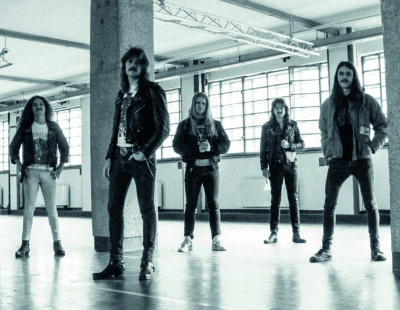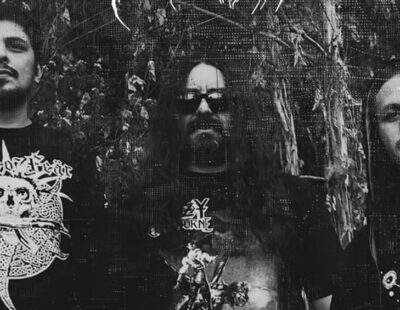by Etan Rosenbloom
500 words an issue is barely enough to spell my name, let alone introduce an entire sector of the music industry in the monthly Killing Is My Business column we introduced in Decibel issue 110. That’s why we’ll be posting occasional interviews and supplementary materials right here on the Deciblog. The idea is to explain how people that make money through metal do their thing – and maybe inspire you to do the same.
Issue 111’s KIMB column is all about audio/visual licensing. Finding the right music for a film, TV show, commercial or other A/V project can be a complex process involving the band, whoever’s buying the music, publishers, record labels and an intermediary – a music supervisor or licensing specialist.
Pixar & Walt Disney Animation SVP of Music (and closet metalhead) Tom MacDougall represents the “music buyer” side of the equation. Here’s my interview with him about how and why he licensed Mastodon’s “Island” for Pixar’s Monsters University.
From a creative standpoint, why did the Pixar team select “Island” for that scene in Monsters University? Were there other songs in contention?
Animation is obviously a long process, but also a process where we experiment a lot, all geared towards us not committing to work that we’re gonna have to ultimately throw away. In live-action, where you might shoot a scene 10 different times, with different lighting and different takes and all that sort of thing, we go through a process of storyboarding which is our experimentation process, so that we don’t animate things that don’t get used, because animation’s expensive and time-consuming.
One of the things we do is we just throw up ideas in that free form, and see what sticks. I think it was the picture editor that put Mastodon in there, and it just worked. We wanted the polar opposite of that character, the music you would least expect her to be listening to. There’s just something about that scream that seems inaccessible, so far-reaching in terms of… what anyone would listen to, but certainly that character. It just felt like a perfect match.
https://youtu.be/NBehYAWxVqA
So this was “temp” music.
Yeah. We tried on stuff, I pitched some other stuff, but it was almost like I did it [because of] what my job is – to come up with as many ideas as I can. But it wasn’t like I looked at it and thought, “We need other ideas.” It was like, “Oh, that’s amazing, and I’ll come up with some other ideas, but I’m not sure I’m ever gonna beat it.” Ultimately we didn’t.
I’ve read that Mastodon had originally been asked to write something original, but the filmmakers decided against it at the last minute. Do you know why that decision was made?
We temped [“Island”] in there, then we went to them [to ask for something new] almost for fun. It seemed like a fun way to have the band be more specifically involved. But as happens a lot of times in Hollywood, we hit this temp love thing, where the thing we had just worked so well. The guys were great, and the thing they came up with was great, and I think if it was in the movie no one would have noticed, but it was the type of thing where we were too close to it. But they couldn’t have been better about it. They said, “Whatever is the best thing for the movie, we’re on board.” It really worked out for the best.
Lay out how the negotiation goes once you decide, “Yes, we’re willing to work with you, Mastodon.” What kinds of rights do you have to negotiate?
It’s pretty straightforward – you need the right to use it in the movie. It’s a matter of how much it’s gonna cost. The bigger thing is to make sure the artist is interested in the idea. Obviously that moment in the movie is not like a big idea – it’s a big joke, it’s a laugh, but it’s not like we’re treading on their brand, or overreaching in terms of what we look to do with it. We just wanted it to play in that one moment. It usually just comes down to, “Is the artist a fan of Pixar? A fan of movies? A fan of us?” Whatever it is. And then if those things line up, there are industry practices that come into play of what those things cost. Once you get the first step, the second step’s pretty easy.
It seems like Pixar is so beloved universally that the label and the publisher are gonna want to work with you. It’s just a matter of working out a fee.
Yeah. And we tell them what we’re up to, what the scene is. There are some artists that don’t like to be associated with drug references, or something like that. Obviously not something that I run into here, but as an example, that’s the type of thing they may not want to be associated with in one context vs. another. At Pixar and Disney animation, it’s pretty straight-ahead. Most people are fans to some degree, some of the guys in the band have kids and all that sorta thing. To be able to come home and say, “Hey son! You might not like my record, but here it is in this new movie” is kinda cool as well.
Can you give a ballpark price range for a master + synch license for a placement in a feature film?
It depends. If there’s a connection, sometimes the artist won’t look for very much at all. It might be just a few thousand dollars. But then I remember back in the day, as an example, Guns N’ Roses was almost unlicenseable unless you really paid a lot of money for it. Really, the ballpark would be anywhere from $5,000 to $250,000 dollars. So much is dependent on the use – how long is the use, how prominent is it, is it over the main titles, is it over the end titles, do the characters interact with it, are they singing along, are they dancing to it, are the lyrics reprinted… all those things factor into how much it’s gonna be.
How often do you get the opportunity to license metal or extreme music for a feature film?
We do try. I don’t know if you saw the movie Bolt, the Disney animated movie. The director’s one of my best friends, and we grew up listening to AC/DC and Judas Priest and all those guys. We had this one moment where there was a FedEx-type character who was doing his job, boxing things up… one of the story points in that movie was that the dog Bolt gets accidentally put into a box and shipped off to New York City. Part of the reason that happens is that the kid has a Walkman on, and was listening to music and not paying attention. So the director and I are like, “This is our moment! We should put something cool in there, something we like!” So, we actually put a Motörhead song in the headphones, and that’s what played. You can barely hear it – it’s a more obscure Motörhead song called “Dog Face Boy,” but we picked it as much for the title as we did for the music.
It’s one of those things, again, where we have to create everything in an animated movie. So, everything you see, everything you hear… we don’t have production sound, we don’t set up a camera in a room and the walls and everything are already there. We have to build it all. So, when you have those moments, we really think about them and decide what we want those moments to be. For a moment like that, for us to put Motörhead in there was a thrill. Lemmy was into it, we met him at one of his shows, and he thought it was funny… those are the little moments that really make it.
But then even the Disney animated film Wreck-It Ralph, we had Skrillex score a scene… for us it’s really about storytelling. If there’s an artist that fits in to what we’re doing, we’re gonna go for it. As much as people associate us with kids movies or family entertainment, we don’t look at it that way. We look at it in terms of these movies are for everybody, and if Mastodon has a place in a Pixar movie, we’re gonna put Mastodon in there. We could have created something like that ourselves for free and been done with it, but the Mastodon thing worked. So, we’re happy to be in business with those guys.
Are you mostly working with established artists, or at least people that have labels and publishers attached to them?
Yeah, for the most part. But that has more to do with experience than it does talent. We need to know that people know how to write a song, know how to make changes, know how to deal with certain things, as opposed to someone who might be brand new. If you don’t have a publisher, you’re probably pretty green. But again, we work with anyone that can bring us what we need in terms of making the movie better.
The Monsters University soundtrack album has Randy Newman’s score on it, but not the Mastodon song. Was it pretty clear that it wasn’t gonna make the cut from the beginning?
We talked about it. We didn’t want to upset the Mastodon fans. If we just put the music that was represented in the film, it would only be four seconds. So, we didn’t want to put a four-second Mastodon edit in there, and confuse people into buying it and not getting what they wanted. And then I think putting the full song on there would confuse people equally – they would not remember that from the movie. Again, it was really more about us not overreaching. We didn’t want to sell something that didn’t represent the film.
We’re fans of a lot of things. Movies, comics, video games, toys, but then also metal. We’re big AC/DC fans, Mastodon, whatever. Anything we can do to be aligned with those things, we’re thrilled about it too.







